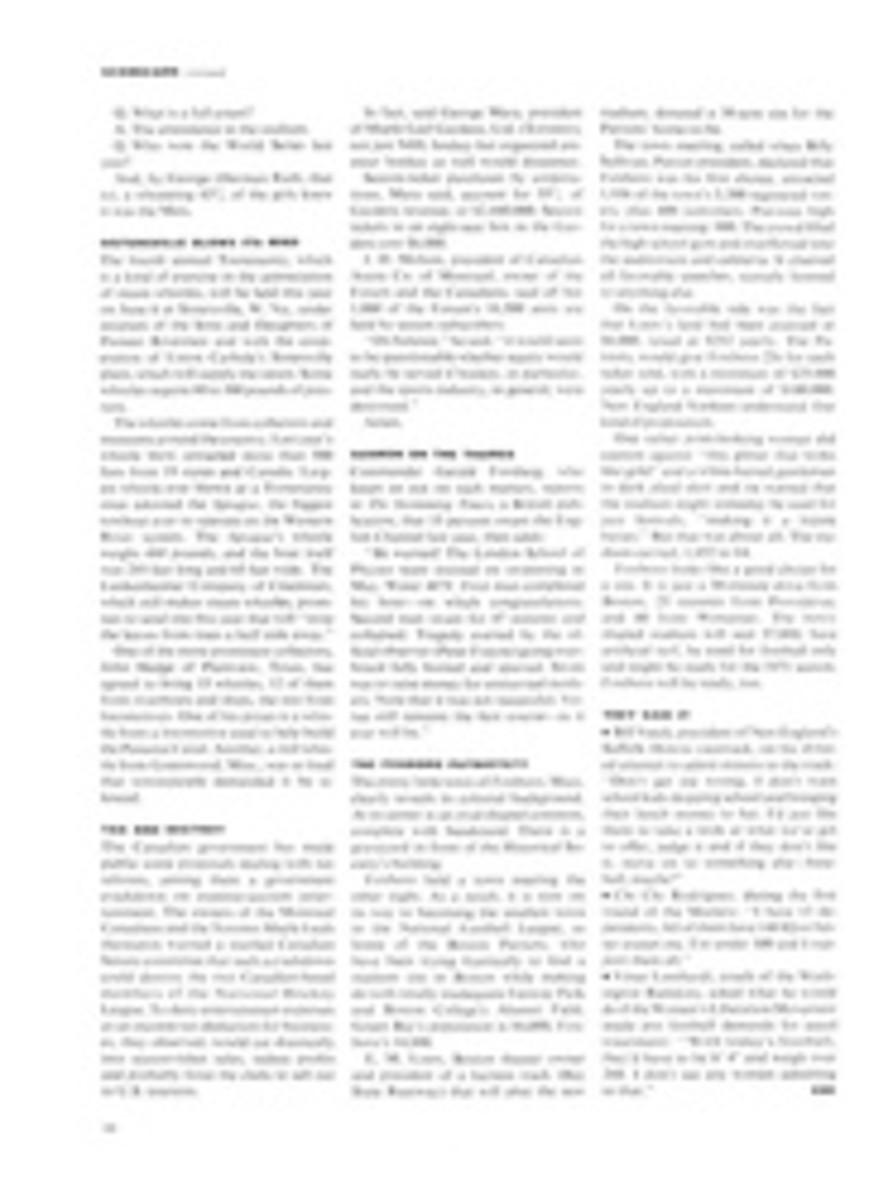
Airplanes and Aqua-Lungs add sporting zest to the adventure of archaeology
Of all the scholarly sciences none holds a closer kinship to sport than the study of archaeology. This was true even when archaeological research was restricted to land-based digs, for the research was always undertaken in the atmosphere and spirit of safari. The diggers themselves needed the skills and disciplines of the camper and the outdoorsman to succeed, and their preoccupation was close to that of the huntsman on the track of an elusive quarry.
Today, thanks to technological advances that both have exploited and enjoyed in their own way, archaeology and sport have come even closer together. This is made enticingly clear in two new books about recent trends in archaeological research, both written for the armchair archaeologist or the lazy layman but filled with enough sense of adventure and the excitement of the chase to delight any sportsman.
One of these books is Leo Deuel's Flights into Yesterday (St. Martin's Press, New York, $8.95), which recounts the comparatively short history of airborne archaeology, a subscience that was born during World War I when the earliest birdmen found they could see things plainly from the air that no landbound scholar would ever notice: a clear view, despite the accumulated camouflage of ages, for instance, of "an entire city crisscrossed by streets or canals and petering out into the desert."
The most striking find of all aerial archaeology is reproduced on the jacket of Deuel's book in a picture of one of the huge sand drawings of Peru's Nazca Desert. It shows a vivid representation of a monkey, 150 yards tall, drawn in sand and pebbles centuries ago and, up to recently, visible in comprehensible form (if they were able to comprehend it) only to high flying birds. For years landbound explorers presumed that the wide lines of the monkey's limbs and tail were canals or roads built by some ancient engineers. What a thing to come across in an afternoon's joyride in your sporty little Piper Cub!
The other book, which may lure even more sportsmen into the field, is Peter Throckmorton's Shipwrecks and Archaeology (Atlantic-Little, Brown, $6.95), a fascinating account of maritime archaeology by one of its pioneer practitioners. The study of sunken ships grew up with the hobby of scuba diving and is largely dependent on that sport's principal tool: the Aqua-Lung. Many of its early followers were purely recreational divers, who started out searching for old wrecks for fun or treasure and came back to them as serious students.
Of all the ways to study past civilizations none is perhaps tidier than the investigation of a sunken ship, for everything aboard on the day she foundered is likely to be an object of current use; there are no accumulated layers to confuse the dater. The trick, however, is to find the ship and her cargo and to find them in a reasonable state of preservation.
If a doomed vessel is lucky enough (from the archaeologist's point of view) to go down to a soft bottom and be covered promptly with an ooze of mud she may last for centuries virtually intact. If, on the other hand, she lights on a hard bottom, to be buffeted and bashed by restless currents, nibbled on by hungry sea creatures and electrolytic chemicals, she may leave behind only a shadowy skeleton of herself.
Going after such a ship from the starting point of some record in a maritime library makes a fascinating game in itself. "If we know what the ship was made of," writes Throckmorton, a research associate at the University of Pennsylvania, "what kind of water she sank in, and what kind of bed awaited her, we can more or less predict the course of her life-in-death." But such things are usually hard to know, and the investigation of them makes for eerie and sometimes heart-stopping adventure.
For the archaeologist with zest there is virtually no limit to the quarry available. In the single small span of five years, from 1864 to 1869, for instance, 10,000 sailing ships insured by British companies were lost at sea—and that was in the days when Britain and presumably Britain's sailors claimed they ruled the waves.
Even today great vessels like the Andrea Doria, sailing serenely in mid-ocean, can take a complete record of 20th-century culture—and 20th century navigational aids—to the bottom in a surprise package for some archaeologist of the future. Before the days of sonar and radar and satellite navigation a single treacherous reef or rock could claim ship after ship over centuries. "A good example of this," writes Throckmorton, "is at Yassi Ada, a small island between Kos and Kalymnos and Bodrum off the Turkish mainland, where we found more than fifteen wrecks. The earliest was a ship of the third century B.C. The collection on the reef includes a Byzantine coastal trader, a big cargo ship from Rhodes of the first century A.D., a nineteenth-century warship and a local sailing caíque that sank in the 1930s."
Dr. Throckmorton is unhappy about the vast numbers of untrained explorers who charge into such treasure houses with bull-in-china-shop clumsiness to disturb valuable finds and to upset history before the scholars can swim down to record it. Despite his stern admonishments, however, his absorbing book is not likely to keep them away. Quite, one suspects, the opposite.

